Geochemistry of Toxic Elements and Their Removal via the Preparation of High-Uranium Coal in Southwestern China
Abstract
:1. Introduction
2. Geological Setting
3. Samples and Methods
3.1. Samples
3.2. Methods
4. Results and Discussion
4.1. Geochemistry of Toxic Elements in High-U Coal from China
4.2. Geochemistry of High-U Coal from Southwestern China
4.2.1. Coal Chemistry
4.2.2. Trace Elements
4.3. The Mode of Occurrence of Toxic Elements in High-U Coals from Southwestern China
4.3.1. Mineralogy
4.3.2. The Extraction of Toxic Elements Using Dilute HCl
4.4. The Partitioning of Toxic Elements during the Flotation of High-U Coal from Southwestern China
4.4.1. The Distribution of Toxic Elements during Flotation
- (1)
- The content of most toxic elements in the GH1 cleaned coal sample is lower than that in feed coal but, with the exception of Co and Ni, the contents of other elements are closer to those of feed coal. The contents of V, Cr, Mo, Th, and U in cleaned coal are higher than, or close to, those of feed coal.
- (2)
- Similar to the sample of GH1, the contents of most toxic elements in GH2 cleaned coal is lower than those in feed coal, while Cs and Ni have a high removal rate in cleaned coals. The contents of V, Cr, Mo, and U in cleaned coal are higher than, or near to, those of feed coal.
- (3)
- Due to flotation, the contents of most toxic elements (Co, Ni, Cu, Zn, Cs, Tl, and Th) in RY1 cleaned coal are lower than those in feed coal, while the contents of other elements (Be, V, Cr, Mo, and U) are closer to, or higher, than those in feed coal.
- (4)
- The contents of most toxic elements in RY2 cleaned coal are reduced; for example, the contents of Cr, Co, Ni, Cu, Zn, Mo, Sb, Cs, Tl, Pb, and Bi are far below those of feed coal, while the contents of V and U in cleaned coal are higher than those in feed coal.
4.4.2. The Removability of Toxic Elements by Flotation
5. Conclusions
- (1)
- High-U coals are mainly distributed in Southwestern China, and most of them are characterized by a high content of organic S and V-Cr-Mo-U element assemblage. The correlation between V, Cr, Mo, and U is good, while the elements V, Cr, Mo, and U have a negative correlation with ash yield and a positive correlation with organic S, indicating that these elements are syngenetic in origin and mainly occur in the organic matter.
- (2)
- Mineralogical characteristics indicate that U in Ganhe and Rongyang coal occurs in anatase, clay minerals, guadarramite, and pyrite, while V occurs in clay minerals, pyrite, and dolomite; Cr occurs in dolomite, and F, Pb, Se, and Hg mainly occur in pyrite. These minerals are all fine-grained.
- (3)
- Gravity separation reveals that the contents of the enriched elements V, Cr, Mo, and U in Rongyang coal are still higher than, or close to, those of feed coal because these elements are derived from hydrothermal fluids in the stage of syngenesis or early diagenesis. At the same time, other elements (F, Mn, Zn, Pb, As, Se, and Hg) can also be efficiently removed.
- (4)
- Most of the elements in Ganhe and Rongyang coals can be removed by flotation, and the content of V, Cr, Mo, and U is higher than, or close to, that of feed coal. Thus, a portion of V and Cr in the cleaned coal obtained by gravity separation are removed via a flotation test, while Mo and U still cannot be removed. The results of this study show that the use of the two industrialized coal preparation methods, gravity separation, and flotation cannot effectively remove U from high-U coal.
- (5)
- Dilute HCl was used to extract toxic elements. The extraction rate of Mo reached 74% and indicates that most Mo exists in an adsorbed state, while V, Cr, Co, Ni, and U are partially absorbed, and the remainder of these components occur in minerals or are complexed with organic matter. The results of this study show that the adsorbed elements V, Cr, Mo, and U can be removed using acid. As U cannot be fully removed from coal, we, therefore, suggest that use of high-U coal should be avoided.
Acknowledgments
Author Contributions
Conflicts of Interest
Appendix A
- Method 1: 4 g of coal is put into a centrifuge tube, then added to 30 mL of 2 M HCl for 24 h (interval ultrasonic shaking) and, finally, centrifuged;
- Method 2: 4 g of coal is put into a centrifuge tube, then added to 30 mL of 4 M HCl for 24 h (interval ultrasonic shaking) and, finally, centrifuged;
- Method 3: 0.5 g of coal is put into a centrifuge tube, then added to 20 mL of 2 M HCl for 24 h (interval ultrasonic shaking) and, finally, centrifuged;
- Method 4: 0.5 g of coal is put into a centrifuge tube, then added to 20 mL of 4 M HCl for 24 h (interval ultrasonic shaking) and, finally, centrifuged.
References
- Dai, S.; Ren, D.; Chou, C.-L.; Finkelman, R.B.; Seredin, V.V.; Zhou, Y. Geochemistry of trace elements in Chinese coals: A review of abundances, genetic types, impacts on human health, and industrial utilization. Int. J. Coal Geol. 2012, 94, 3–21. [Google Scholar] [CrossRef]
- Dai, S.; Ren, D.; Zhou, Y.; Chou, C.-L.; Wang, X.; Zhao, L.; Zhu, X. Mineralogy and geochemistry of a super high-organic-sulfur coal, Yanshan Coalfield, Yunnan, China: Evidence for a volcanic ash component and influence by submarine exhalation. Chem. Geol. 2008, 255, 182–194. [Google Scholar] [CrossRef]
- Dai, S.; Zhang, W.; Seredin, V.V.; Ward, C.R.; Hower, J.C.; Song, W.; Wang, X.; Li, X.; Zhao, L.; Kang, H.; et al. Factors controlling geochemical and mineralogical compositions of coals preserved within marine carbonate successions: A case study from the Heshan Coalfield, southern China. Int. J. Coal Geol. 2013, 109–110, 77–100. [Google Scholar] [CrossRef]
- Dai, S.; Zhang, W.; Ward, C.R.; Seredin, V.V.; Hower, J.C.; Li, X.; Song, W.; Wang, X.; Kang, H.; Zheng, L.; et al. Mineralogical and geochemical anomalies of late Permian coals from the Fusui Coalfield, Guangxi Province, southern China: Influences of terrigenous materials and hydrothermal fluids. Int. J. Coal Geol. 2013, 105, 60–84. [Google Scholar]
- Dai, S.; Xie, P.; Ward, C.R.; Yan, X.; Guo, W.; French, D.; Graham, I.T. Anomalies of rare metals in Lopingian super-high-organic-sulfur coals from the Yishan Coalfield, Guangxi, China. Ore Geol. Rev. 2017, 88, 235–250. [Google Scholar] [CrossRef]
- Li, W.; Tang, Y.; Deng, X.; Yu, X.; Jiang, S. Geochemistry of the trace elements in the high-organic-sulfur coals from Chenxi coalfield. J. China Coal Soc. 2013, 38, 1223–1227. (In Chinese) [Google Scholar]
- Dai, S.; Seredin, V.V.; Ward, C.R.; Hower, J.C.; Xing, Y.; Zhang, W.; Song, W.; Wang, P. Enrichment of U-Se-Mo-Re-V in coals preserved within marine carbonate successions: Geochemical and mineralogical data from the Late Permian Guiding Coalfield, Guizhou, China. Miner. Depos. 2015, 50, 159–186. [Google Scholar] [CrossRef]
- Dai, S.; Finkelman, R.B. Coal as a promising source of critical elements: Progress and future prospects. Int. J. Coal Geol. 2018, 186, 155–164. [Google Scholar] [CrossRef]
- Wang, X.; Feng, Q.; Fang, T.; Liu, J.; Liu, G. Geochemical characteristics of uranium in medium to high sulfur coals from Eastern Yunnan, China. J. China Coal Soc. 2015, 40, 2451–2457. (In Chinese) [Google Scholar]
- Yudovich, Y.E.; Ketris, M.P. Toxic Trace Elements in Fossil Coals; UrO RAN: Yekaterinburg, Russia, 2005. (In Russian) [Google Scholar]
- Yudovich, Y.E.; Ketris, M.P. Geochemistry of Coal: Occurrences and Environmental Impacts of Trace Elements. In Coal Production and Processing Technology; CRC Press: Boka Raton, FL, USA, 2015; pp. 48–73. [Google Scholar]
- Arbuzov, S.I.; Volostnov, A.V.; Rikhvanov, L.P.; Mezhibor, A.M.; Ilenok, S.S. Geochemistry of radioactive elements (U, Th) in coal and peat of northern Asia (Siberia, Russian Far East, Kazakhstan, and Mongolia). Int. J. Coal Geol. 2011, 86, 318–328. [Google Scholar] [CrossRef]
- Zivotić, D.; Grzetić, I.; Lorenz, H.; Simić, V. U and Th in some brown coals of Serbia and Montenegro and their environmental impact. Environ. Sci. Pollut. Res. 2008, 15, 155–161. [Google Scholar] [CrossRef]
- Etschmann, B.; Liu, W.; Li, K.; Dai, S.; Reith, F.; Falconer, D.; Kerrf, G.; Patersong, D.; Howardg, D.; Kappeng, P.; et al. Enrichment of germanium and associated arsenic and tungsten in coal and roll-front uranium deposits. Chem. Geol. 2017, 463, 29–49. [Google Scholar] [CrossRef]
- Lauer, N.; Vengosh, A.; Dai, S. Naturally Occurring Radioactive Materials in Uranium-Rich Coals and Associated Coal Combustion Residues from China. Environ. Sci. Technol. 2017, 51, 13487–13493. [Google Scholar] [CrossRef] [PubMed]
- Melo, D.; Burkart, W. Uranium-environmental pollution and health effects. Encycl. Environ. Health 2011, 2, 526–533. [Google Scholar]
- Cheng, W.; Zhang, Q.; Yang, R.; Tian, Y. Occurrence modes and cleaning potential of sulfur and some trace elements in a high-sulfur coal from Pu’an coalfield, SW Guizhou, China. Environ. Earth Sci. 2013, 72, 35–46. [Google Scholar] [CrossRef]
- Duan, P.; Wang, W.; Liu, X.; Qian, F.; Sang, S.; Xu, S. Distribution of As, Hg and other trace elements in different size and density fractions of the Reshuihe high-sulfur coal, Yunnan Province, China. Int. J. Coal Geol. 2017, 173, 129–141. [Google Scholar] [CrossRef]
- Kolker, A.; Senior, C.; Alphen, C.V.; Koenig, A.; Geboy, N. Mercury and trace element distribution in density separates of a South African Highveld (#4) coal: Implications for mercury reduction and preparation of export coal. Int. J. Coal Geol. 2016, 170, 7–13. [Google Scholar]
- Luo, G.; Ma, J.; Han, J.; Yao, H.; Xu, M.; Zhang, C.; Chen, G.; Gupta, R.; Xu, Z. Hg occurrence in coal and its removal before coal utilization. Fuel 2013, 104, 70–76. [Google Scholar] [CrossRef]
- Song, D.; Zhang, X.; Zhang, J.; Zheng, C. Migration characteristics of hazardous trace elements in coal in the process of flotation. J. China Coal Soc. 2010, 35, 1170–1176. (In Chinese) [Google Scholar]
- Wang, W.; Qin, Y.; Sang, S.; Jiang, B.; Guo, Y.; Zhu, Y.; Fu, X. Partitioning of minerals and elements during preparation of Taixi coal, China. Fuel 2006, 85, 57–67. [Google Scholar] [CrossRef]
- Wang, W.; Qin, Y.; Wei, C.; Li, Z.; Guo, Y.; Zhu, Y. Partitioning of elements and macerals during preparation of Antaibao coal. Int. J. Coal Geol. 2008, 68, 223–232. [Google Scholar] [CrossRef]
- Wang, W.; Qin, Y.; Wang, J.; Li, J. Partitioning of hazardous trace elements during coal preparation. Procedia Earth Planet. Sci. 2009, 1, 838–844. [Google Scholar]
- Wang, W.; Qin, Y. Partitioning of Hazardous Elements and Minerals during Coal Cleaning; China University of Mining and Technology Press: Xuzhou, China, 2011. (In Chinese) [Google Scholar]
- Wang, L. The study on removal of trace elements in coal by coal preparation. Clean Coal Technol. 2007, 13, 13–17. (In Chinese) [Google Scholar]
- Li, S.; Jiao, H. Progress of hazardous trace elements removal during coal washing. Coal Convers. 2011, 34, 87–91. (In Chinese) [Google Scholar]
- Pan, J.; Zhou, C.; Cong, L.; Zhang, N.; Liu, C.; Peng, C.; Ouyang, C. Mercury in Chinese Coals: Modes of Occurrence and its Removal Statistical Laws during Coal Separation. Energy Fuels 2016, 31, 986–995. [Google Scholar] [CrossRef]
- Zhou, C.; Zhang, N.; Peng, C.; Cong, L.; Ouyang, C.; Han, R. Arsenic in Coal: Modes of Occurrence, Distribution in Different Fractions, and Partitioning Behavior during Coal Separation—A Case Study. Energy Fuels 2016, 30, 3233–3240. [Google Scholar] [CrossRef]
- Dai, S.; Yan, X.; Ward, C.R.; Hower, J.C.; Zhao, L.; Wang, X.; Zhao, L.; Ren, D.; Finkelman, R.B. Valuable elements in Chinese coals: A review. Int. Geol. Rev. 2016. [Google Scholar] [CrossRef]
- Duan, P.; Wang, W.; Sang, S.; Qian, F.; Shao, P.; Zhao, X. Partitioning of hazardous elements during preparation of high-uranium coal from Rongyang, Guizhou, China. J. Geochem. Explor. 2018, 185, 81–92. [Google Scholar] [CrossRef]
- Xu, B.; He, M. Guizhou Coalfield Geology; China University of Mining and Technology Press: Xuzhou, China, 2003. (In Chinese) [Google Scholar]
- Zhao, Y.; Zeng, F.; Liang, H.; Tang, Y.; Li, M.; Xiang, J.; Wen, X. Chromium and vanadium bearing nanominerals and ultra-fine particles in a super-high-organic-sulfur coal from Ganhe coalmine, Yanshan Coalfield, Yunnan, China. Fuel 2017, 203, 832–842. [Google Scholar] [CrossRef]
- Dai, S.; Wang, X.; Zhou, Y.; Hower, C.J.; Li, D.; Chen, W.; Zhu, X. Chemical and mineralogical compositions of silicic, mafic, and alkali tonsteins in the late Permian coals from the Songzao Coalfield, Chongqing, Southwest China. Chem. Geol. 2011, 282, 29–44. [Google Scholar] [CrossRef]
- Dai, S.; Wang, X.; Seredin, V.V.; Hower, J.C.; Ward, C.R.; O’Keefe, J.M.K.; Huang, W.; Li, T.; Li, X.; Liu, H.; et al. Petrology, mineralogy, and geochemistry of the Ge-rich coal from the Wulantuga Ge ore deposit, Inner Mongolia, China: New data and genetic implications. Int. J. Coal Geol. 2012, 90–91, 72–99. [Google Scholar] [CrossRef]
- Dai, S.; Li, T.; Jiang, Y.; Ward, C.R.; Hower, J.C.; Sun, J.; Liu, J.; Song, H.; Wei, P.; Li, Q.; Xie, P.; Huang, Q. Mineralogical and geochemical compositions of the Pennsylvanian coal in the Hailiushu Mine, Daqingshan Coalfield, Inner Mongolia, China: Implications of sediment-source region and acid hydrothermal solutions. Int. J. Coal Geol. 2015, 137, 92–110. [Google Scholar] [CrossRef]
- Methods for the Batch Flotation Testing of Fine Coal; GB/T 4757-2001 (National Standard of P.R. China); Standardization Administration of China: Beijing, China, 2001. (In Chinese)
- Fisher, Q.J.; Cliff, R.A.; Dodson, M.H. U-Pb systematics of an Upper Carboniferous black shale from South Yorkshire, UK. Chem. Geol. 2003, 194, 331–347. [Google Scholar] [CrossRef]
- Qin, Y.; Zhang, W.; Peng, P.; Zhou, Z. Occurrence and concentration of uranium in the hydrocarbon source rocks of Chang 7 member of Yanchang Formation, Ordos Basin. Acta Petrol. Sin. 2009, 25, 2469–2476. (In Chinese) [Google Scholar]
- Dai, S.; Yang, J.; Ward, C.R.; Hower, J.C.; Liu, H.; Garrison, T.M.; French, D.; O’keefe, J.M.K. Geochemical and mineralogical evidence for a coal-hosted uranium deposit in the Yili Basin, Xinjiang, northwestern China. Ore Geol. Rev. 2015, 70, 1–30. [Google Scholar] [CrossRef]
- Dai, S.; Liu, J.; Ward, C.R.; Hower, J.C.; French, D.; Jia, S.; Hood, M.M.; Garrison, T.M. Mineralogical and geochemical compositions of Late Permian coals and host rocks from the Guxu Coalfield, Sichuan Province, China, with emphasis on enrichment of rare metals. Int. J. Coal Geol. 2016, 166, 71–95. [Google Scholar] [CrossRef]
- Dai, S.; Wang, P.; Ward, C.R.; Tang, Y.; Song, X.; Jiang, J.; Hower, J.C.; Li, T.; Seredin, V.V.; Wagner, N.J.; et al. Elemental and mineralogical anomalies in the coal-hosted Ge ore deposit of Lincang, Yunnan, southwestern China: Key role of N2-CO2-mixed hydrothermal solutions. Int. J. Coal Geol. 2015, 152, 19–46. [Google Scholar] [CrossRef]
- Dai, S.; Han, D.; Chou, C.-L. Petrography and geochemistry of the Middle Devonian coal from Longquan, Yunnan Province, China. Fuel 2006, 85, 456–464. [Google Scholar] [CrossRef]
- Dai, S.; Ren, D.; Hou, X.; Shao, L. Geochemical and mineralogical anomalies of the late Permian coal in the Zhijin coalfield of southwest China and their volcanic origin. Int. J. Coal Geol. 2003, 55, 117–138. [Google Scholar] [CrossRef]
- Dai, S.; Xie, P.; Jia, S.; Ward, C.R.; Yan, X.; French, D. Enrichment of U-Re-V-Cr-Se and rare earth elements in the Late Permian coals of the Moxinpo Coalfield, Chongqing, China: Genetic implications from geochemical and mineralogical data. Ore Geol. Rev. 2017, 80, 1–17. [Google Scholar] [CrossRef]
- Ketris, M.P.; Yudovich, Y.E. Estimations of Clarkes for carbonaceous biolithes: World average for trace element contents in black shales and coals. Int. J. Coal Geol. 2009, 78, 135–148. [Google Scholar] [CrossRef]
- Ren, D.; Zhao, F.; Dai, S.; Zhang, J.; Luo, K. Geochemistry of Trace Elements in Coal; Science Press: Beijing, China, 2006. (In Chinese) [Google Scholar]
- Geboy, N.J.; Engle, M.A.; Hower, J.C. Whole-coal versus ash basis in coal geochemistry: A mathematical approach to consistent interpretations. Int. J. Coal Geol. 2013, 113, 41–49. [Google Scholar] [CrossRef]
- Dai, S.; Li, D.; Chou, C.-L.; Zhao, L.; Zhang, Y.; Ren, D.; Ma, Y.; Sun, Y. Mineralogy and geochemistry of boehmite-rich coals: New insights from the Haerwusu Surface Mine, Jungar Coalfield, Inner Mongolia, China. Int. J. Coal Geol. 2008, 74, 185–202. [Google Scholar] [CrossRef]
- Dai, S.; Ren, D.; Tang, Y.; Shao, L.; Li, S. Distribution, isotopic variation and origin of sulfur in coals in the Wuda Coalfield, Inner Mongolia, China. Int. J. Coal Geol. 2002, 51, 237–250. [Google Scholar] [CrossRef]
- ASTM International. Annual Book of ASTM Standards; D388-99 Standard Classification of Coals by Rank; ASTM: West Conshohocken, PA, USA, 2005. [Google Scholar]
- Classification for Quality of Coal. Part 1: Ash; GB/T 15224.1-2004 (National Standard of P.R. China); Standardization Administration of China: Beijing, China, 2004. (In Chinese)
- Chou, C.-L. Sulfur in coals: A review of geochemistry and origins. Int. J. Coal Geol. 2012, 100, 1–13. [Google Scholar] [CrossRef]
- Classification for Quality of Coal. Part 2: Sulfur Content; GB/T 15224.2-2004 (National Standard of P.R. China); Standardization Administration of China: Beijing, China, 2004. (In Chinese)
- Xie, P.; Song, H.; Wei, J.; Li, Q. Mineralogical characteristics of Late Permian coals from the Yueliangtian Coal Mine, Guizhou, southwestern China. Minerals 2016, 6, 29. [Google Scholar] [CrossRef]
- Wang, P.; Ji, D.; Yang, Y.; Zhao, L. Mineralogical compositions of Late Permian coals from the Yueliangtian mine, western Guizhou, China: Comparison to coals from eastern Yunnan, with an emphasis on the origin of the minerals. Fuel 2016, 181, 859–869. [Google Scholar] [CrossRef]
- Han, Y.; Ma, Z. Geochemistry; Geology Publishing House: Beijing, China, 2003. (In Chinese) [Google Scholar]
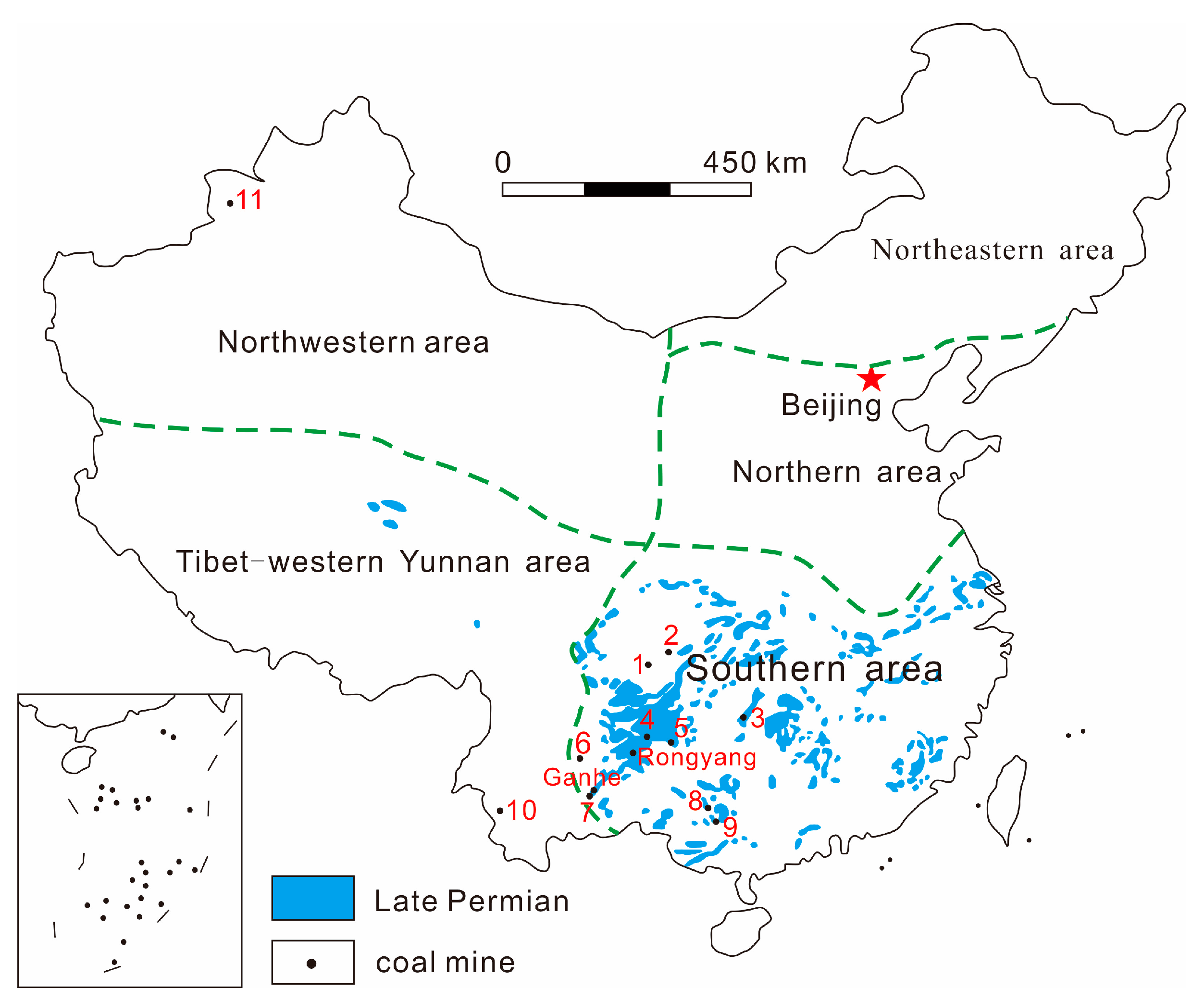

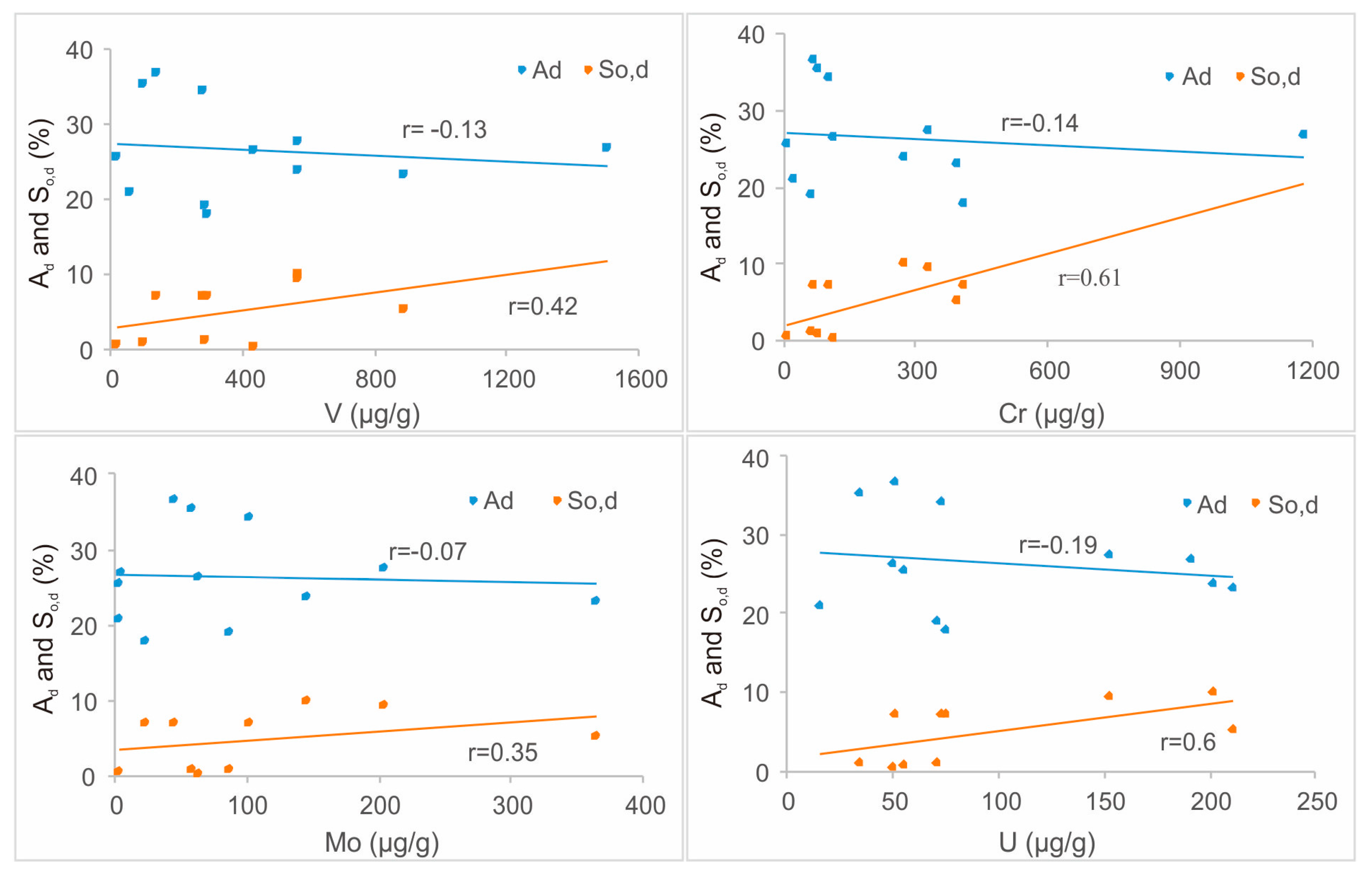
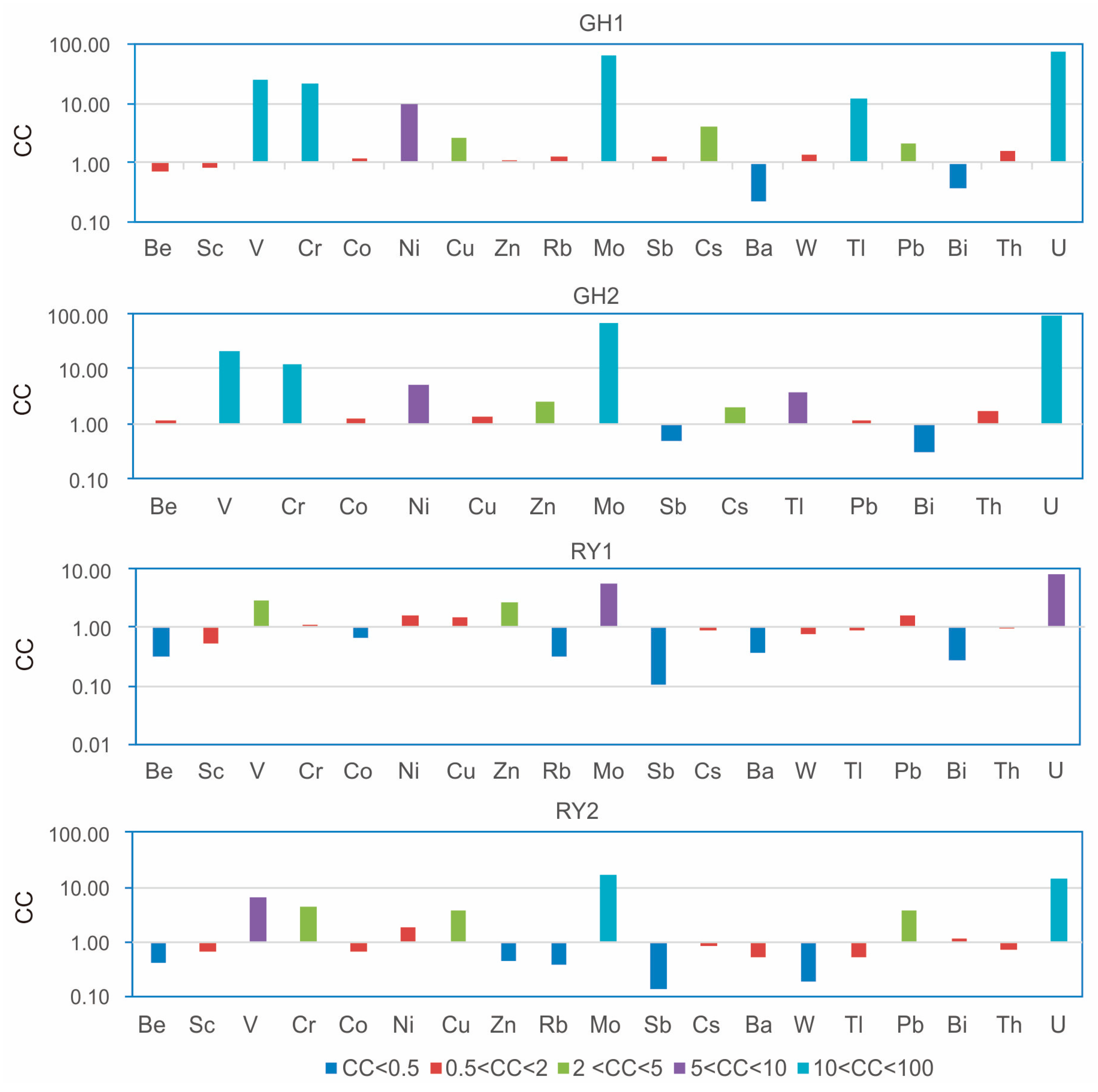
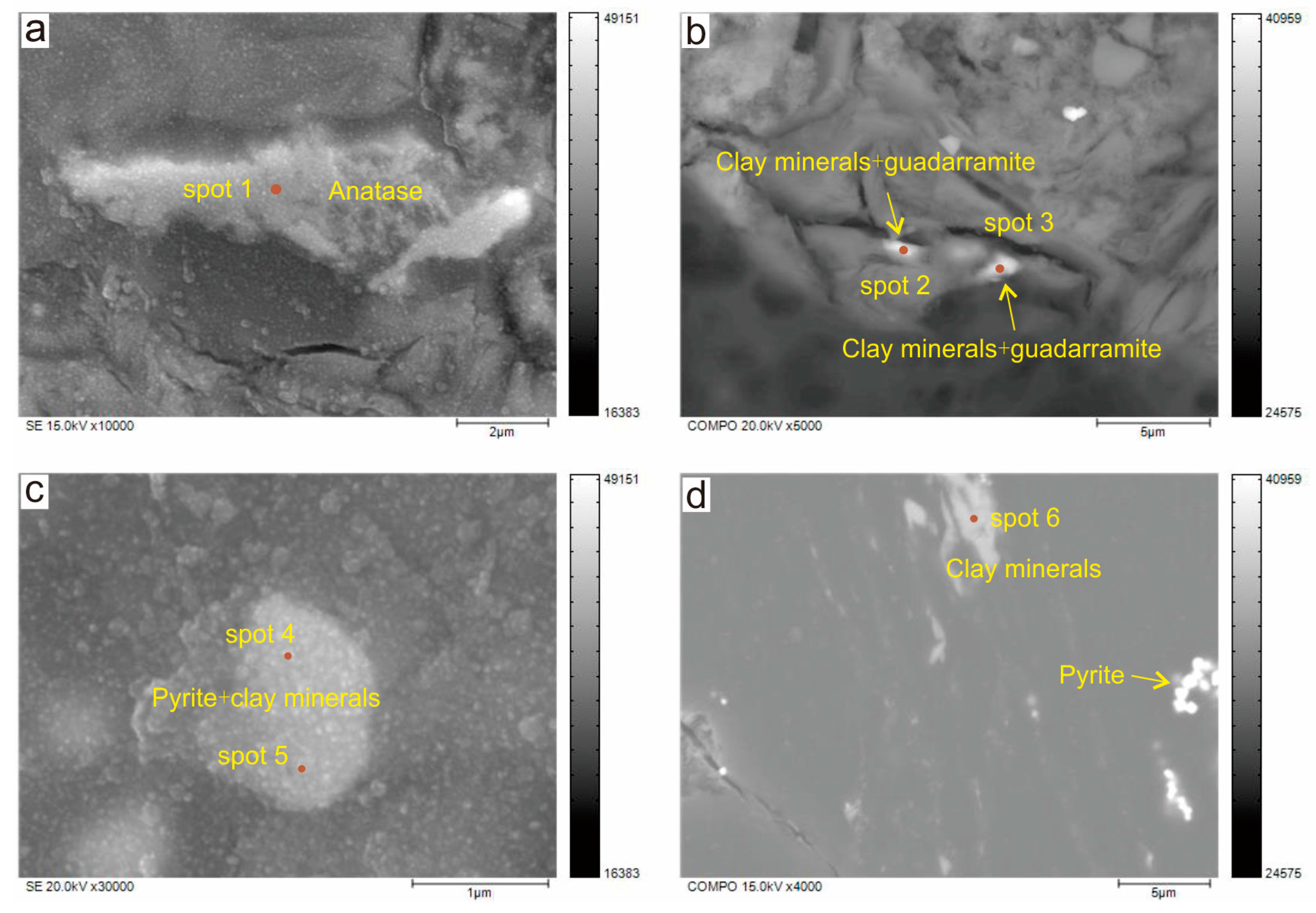
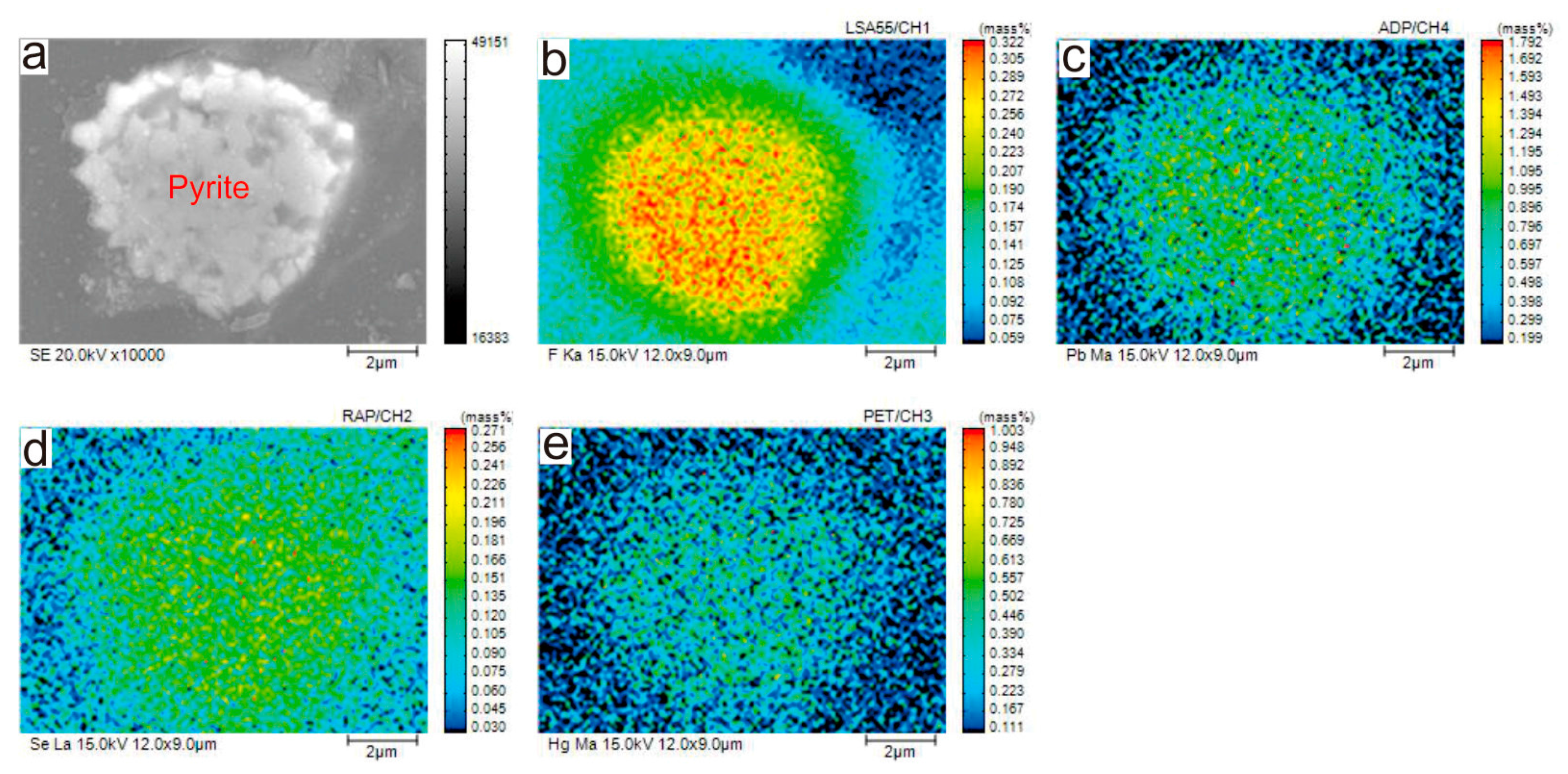
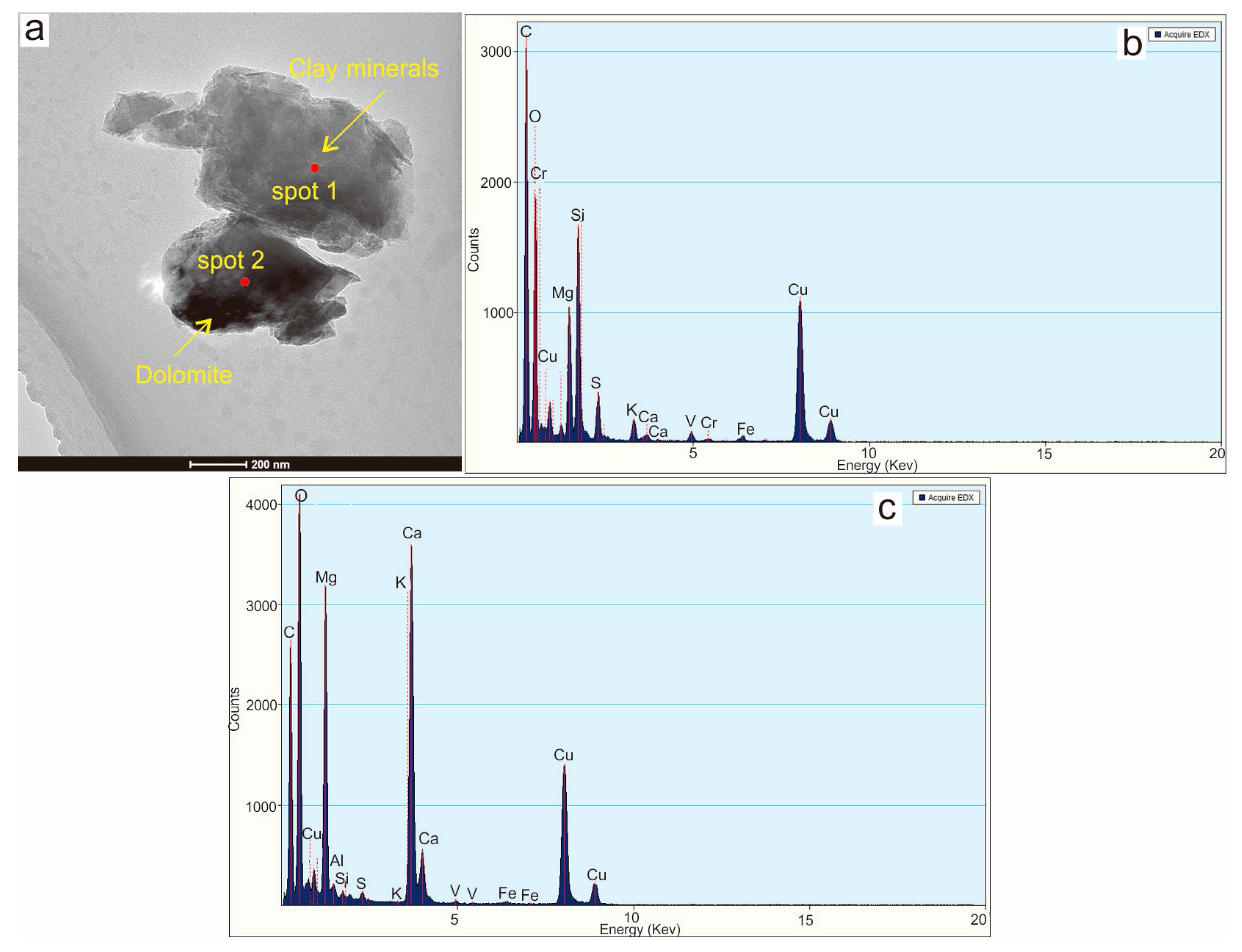
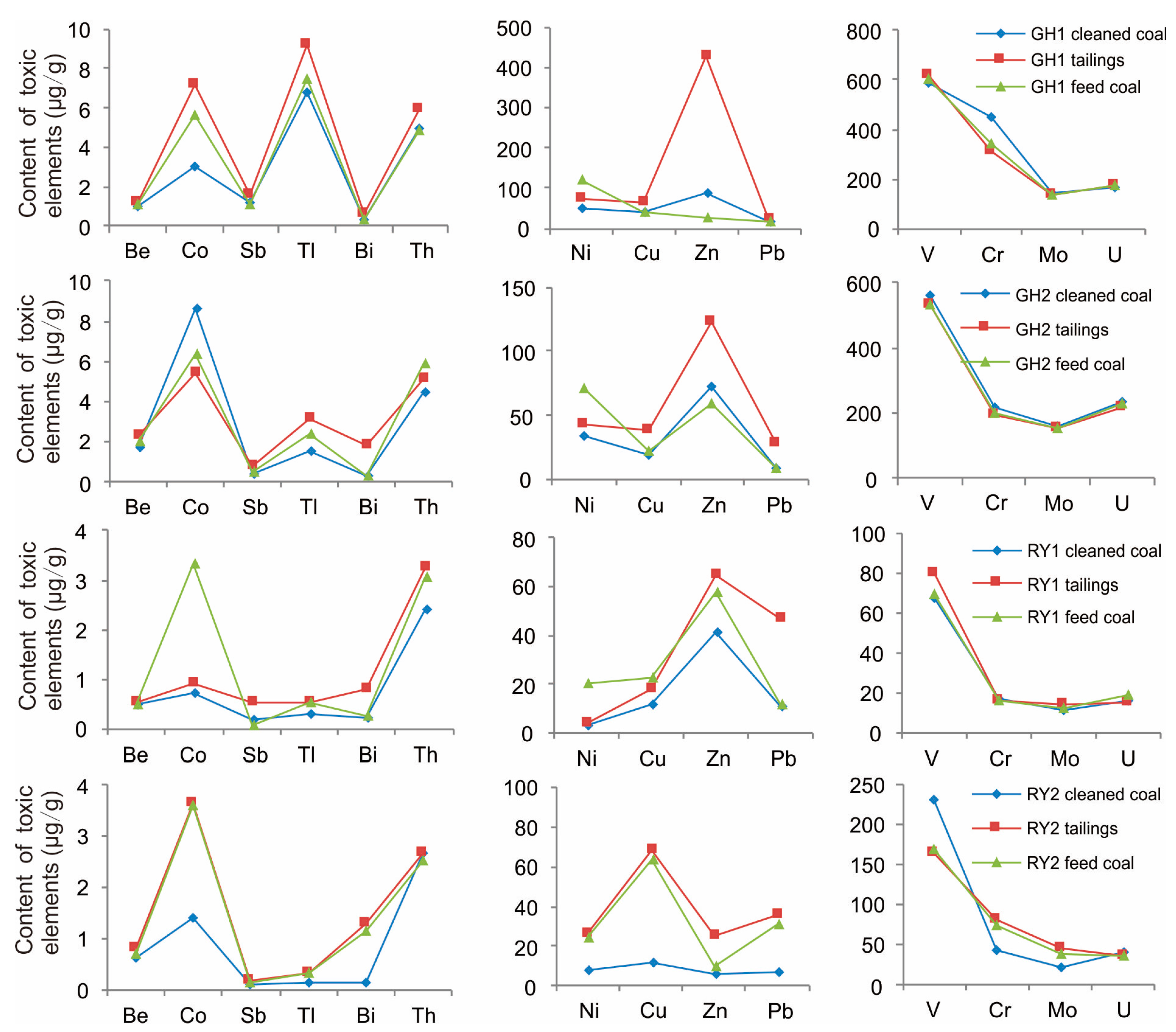
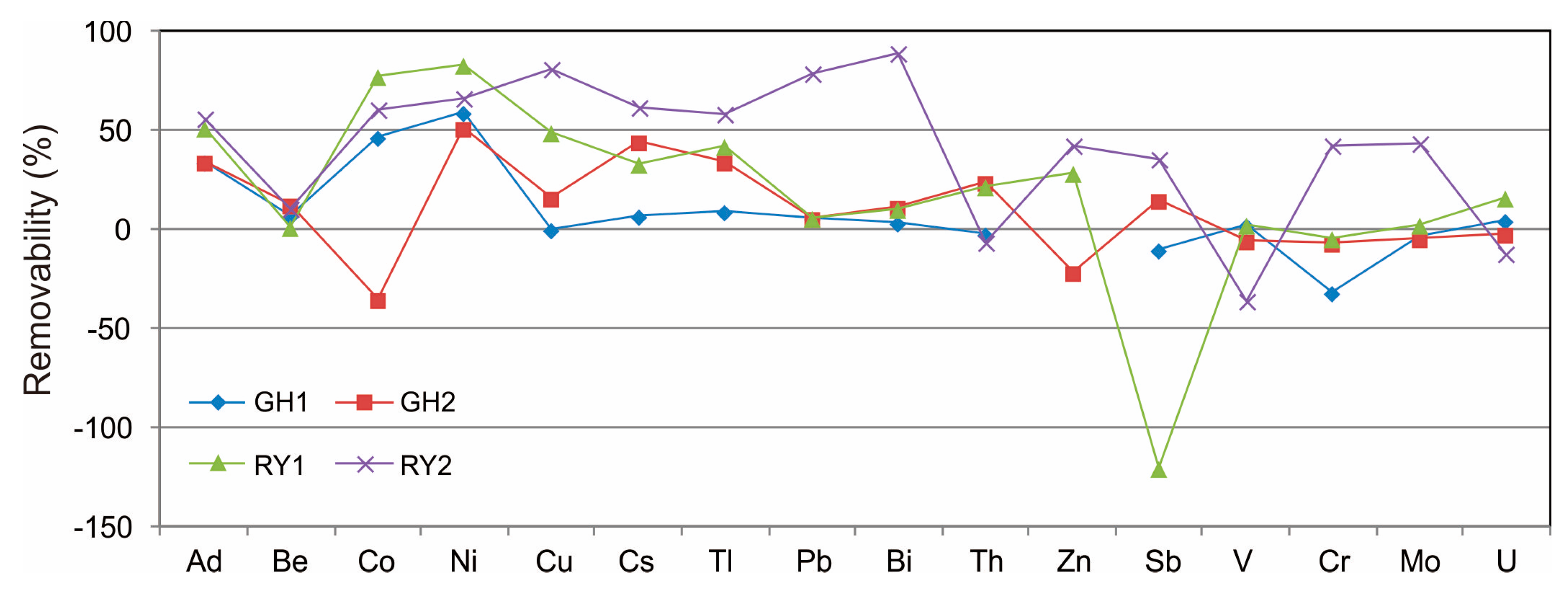
| Coalfield | Ad | So,d | V | Cr | Mo | U | Sources |
|---|---|---|---|---|---|---|---|
| Guiding | 23.10 | 5.19 | 892 | 391 | 364 | 211 | Dai et al. [7] |
| Yanshan | 27.51 | 9.51 | 567 | 329 | 204 | 153 | Dai et al. [2] |
| Heshan * | 36.69 | 7.2 | 136.13 | 69 | 44.7 | 51.13 | Dai et al. [3] |
| Chenxi | 17.97 | 7.12 | 296.3 | 407.75 | 23.19 | 75.2 | Li et al. [6] |
| Yishan * | 34.26 | 7.16 | 278.33 | 102.47 | 101.97 | 72.2 | Dai et al. [5] |
| Guxu | 20.95 | nd | 60.7 | 22.8 | 2.48 | 15.4 | Dai et al. [41] |
| Yili * | 26.88 | nd | 114 | 82.84 | 80.77 | 312 | Dai et al. [40] |
| Lincang * | 25.59 | 0.72 | 18.48 | 5.56 | 3.94 | 54.6 | Dai et al. [42] |
| Longquan | 35.37 | 0.89 | 98.4 | 79 | 58.8 | 34.1 | Dai et al. [43] |
| Zhijin | 26.41 | 0.33 | 432.1 | 113.1 | 63.1 | 49.6 | Dai et al. [44] |
| Moxinpo * | 26.83 | nd | 1507 | 1180 | 4.72 | 190.5 | Dai et al. [45] |
| Rongyang | 19 | 1.06 | 283 | 62.3 | 87.5 | 70.5 | This study |
| Ganhe * | 23.79 | 10.09 | 568 | 273 | 145 | 201 | This study |
| World | nd | nd | 25 | 16 | 2.2 | 2.4 | Ketris and Yudovich [46] |
| Sample | Mad | Ad | Vdaf | St,d | Sp, d | Ss, d | So, d |
|---|---|---|---|---|---|---|---|
| Ronyang | 2.6 | 19 | 8.9 | 5.44 | 4.19 | 0.19 | 1.06 |
| Ganhe | 0.66 | 23.79 | 12.11 | 12.085 | 1.98 | 0.015 | 10.09 |
| Nos. | Spot 1 | Spot 2 | Spot 3 | Spot 4 | Spot 5 | Spot 6 |
|---|---|---|---|---|---|---|
| Na2O | 0.19 | 0.46 | 0.38 | 0.29 | 0.29 | 0.35 |
| MgO | 0.12 | 0.29 | 0.35 | 0.42 | 0.44 | 0.24 |
| Al2O3 | 3.95 | 15.58 | 9.81 | 11.22 | 12.34 | 23.8 |
| SiO2 | 12.73 | 55.63 | 35.72 | 35.79 | 42.57 | 63.9 |
| P2O5 | - | - | - | 3.09 | 1.59 | - |
| SO3 | 1.19 | 1.04 | 5.65 | 20.62 | 15.34 | 6.27 |
| Cl | - | 0.14 | 0.62 | 0.1 | 0.11 | - |
| K2O | 0.76 | 3.43 | 2.12 | 2.95 | 3.48 | 1.42 |
| CaO | 0.31 | 0.54 | 1.28 | 1.57 | 2.08 | 0.67 |
| TiO2 | 72.37 | 3.70 | 7.67 | 0.19 | - | - |
| MnO | - | - | - | - | 0.3 | - |
| V2O5 | - | - | - | - | 0.44 | 1.19 |
| FeO | 4.36 | 16.12 | 30.04 | 22.29 | 19.58 | 2.19 |
| I | 0.45 | - | 0.55 | 1.07 | 0.94 | - |
| BaO | - | - | - | 0.16 | 0.08 | - |
| La2O3 | - | - | - | - | 0.41 | - |
| Nb2O5 | 0.82 | - | - | - | - | - |
| UO2 | 2.76 | 3.07 | 5.79 | 0.24 | - | - |
| Total | 100 | 100 | 100 | 100 | 99.99 | 100 |
| Method No. | Be | V | Cr | Mn | Co | Ni | Cu | Zn | Rb | Sr | Mo | Cs | Ba | U |
|---|---|---|---|---|---|---|---|---|---|---|---|---|---|---|
| 1 | 6.62 | 10.91 | 3.29 | 11.37 | 14.94 | 21.38 | 10.77 | 38.43 | 1.03 | 35.79 | 36.95 | 4.04 | 9.74 | 9.39 |
| 2 | 11.82 | 12.67 | 4.32 | 12.02 | 15.29 | 25.09 | 5.56 | 39.32 | 1.93 | 40.15 | 59.05 | 15.17 | 15.62 | 12.35 |
| 3 | 10.09 | 14.61 | 7.07 | 18.78 | 16.05 | 32.65 | 44.19 | 57.38 | 3.29 | 48.78 | 58.56 | 13.31 | 23.50 | 12.96 |
| 4 | 13.62 | 16.35 | 12.97 | 21.22 | 18.34 | 39.13 | 37.30 | 74.72 | 3.77 | 57.01 | 73.76 | 25.31 | 25.25 | 15.10 |
| Sample No. | Flotation Products | Yield | Ad | Be | V | Cr | Co | Ni | Cu | Zn * | Mo | Sb | Cs | Tl | Pb | Bi | Th | U |
|---|---|---|---|---|---|---|---|---|---|---|---|---|---|---|---|---|---|---|
| GH1 | Cleaned coal | 49.63 | 15.98 | 1.04 | 586 | 453 | 3.03 | 49.7 | 40.6 | 88.3 | 142 | 1.18 | 3.62 | 6.76 | 14.8 | 0.35 | 4.99 | 164 |
| Tailings | 50.37 | 26.32 | 1.22 | 620 | 314 | 7.20 | 75.2 | 62.0 | 427.7 | 136 | 1.63 | 4.91 | 9.20 | 19.8 | 0.60 | 5.96 | 178 | |
| feed coal | 100 | 24.20 | 1.11 | 603 | 344 | 5.67 | 121.5 | 40.9 | 24.6 | 138 | 1.07 | 3.87 | 7.50 | 15.7 | 0.37 | 4.90 | 173 | |
| GH2 | Cleaned coal | 51.04 | 15.45 | 1.72 | 561 | 215 | 8.58 | 34.1 | 18.8 | 72.1 | 159 | 0.38 | 1.11 | 1.52 | 8.8 | 0.27 | 4.42 | 234 |
| Tailings | 48.96 | 27.71 | 2.28 | 533 | 194 | 5.37 | 43.6 | 38.1 | 122.4 | 153 | 0.81 | 2.71 | 3.17 | 27.6 | 1.80 | 5.15 | 218 | |
| Feed coal | 100 | 23.37 | 1.97 | 532 | 202 | 6.33 | 70.5 | 22.3 | 59.2 | 153 | 0.45 | 2.01 | 2.34 | 9.4 | 0.31 | 5.85 | 230 | |
| RY1 | Cleaned coal | 65.14 | 9.19 | 0.50 | 67.4 | 16.8 | 0.74 | 3.4 | 11.4 | 41.3 | 11.6 | 0.20 | 0.57 | 0.32 | 11.1 | 0.23 | 2.40 | 16.0 |
| Tailings | 34.86 | 35.59 | 0.55 | 79.9 | 15.9 | 0.92 | 3.6 | 18.0 | 64.4 | 14.1 | 0.55 | 0.92 | 0.55 | 46.6 | 0.81 | 3.25 | 14.9 | |
| Feed coal | 100 | 19.00 | 0.50 | 69.0 | 16.1 | 3.32 | 20.1 | 22.5 | 58.0 | 12.0 | 0.09 | 0.86 | 0.56 | 11.7 | 0.26 | 3.07 | 19.2 | |
| RY2 | Cleaned coal | 31.22 | 3.96 | 0.62 | 230 | 42.1 | 1.41 | 8.2 | 12.1 | 5.9 | 21.7 | 0.09 | 0.34 | 0.14 | 6.5 | 0.13 | 2.68 | 41.4 |
| Tailings | 68.78 | 10.84 | 0.79 | 163 | 80.8 | 3.63 | 26.0 | 68.3 | 25.6 | 44.5 | 0.17 | 0.94 | 0.34 | 35.6 | 1.31 | 2.67 | 36.4 | |
| Feed coal | 100 | 9.12 | 0.69 | 168 | 73.1 | 3.60 | 24.1 | 63.3 | 10.3 | 38.2 | 0.13 | 0.90 | 0.34 | 30.5 | 1.12 | 2.51 | 37.0 |
| Sample No. | Ad | Be | V | Cr | Co | Ni | Cu | Zn |
| GH1 | 33.97 | 6.84 | 2.93 | −31.68 | 46.54 | 59.08 | 0.70 | - |
| GH2 | 33.89 | 12.58 | −5.36 | −6.28 | −35.56 | 51.54 | 15.68 | −21.79 |
| RY1 | 51.63 | 1.24 | 2.28 | −4.30 | 77.56 | 83.01 | 49.24 | 28.79 |
| RY2 | 56.62 | 10.17 | −36.68 | 42.43 | 60.77 | 65.90 | 80.93 | 42.72 |
| Sample No. | Mo | Sb | Cs | Tl | Pb | Bi | Th | U |
| GH1 | −3.17 | −10.20 | 6.62 | 9.86 | 5.69 | 3.36 | −1.84 | 5.10 |
| GH2 | −4.13 | 15.53 | 44.93 | 34.90 | 6.48 | 12.08 | 24.44 | −2.02 |
| RY1 | 2.96 | −120.67 | 33.20 | 42.04 | 5.55 | 10.52 | 21.82 | 16.31 |
| RY2 | 43.16 | 35.15 | 62.15 | 58.44 | 78.72 | 88.62 | −6.77 | −11.88 |
© 2018 by the authors. Licensee MDPI, Basel, Switzerland. This article is an open access article distributed under the terms and conditions of the Creative Commons Attribution (CC BY) license (http://creativecommons.org/licenses/by/4.0/).
Share and Cite
Duan, P.; Wang, W.; Sang, S.; Tang, Y.; Ma, M.; Zhang, W.; Liang, B. Geochemistry of Toxic Elements and Their Removal via the Preparation of High-Uranium Coal in Southwestern China. Minerals 2018, 8, 83. https://doi.org/10.3390/min8030083
Duan P, Wang W, Sang S, Tang Y, Ma M, Zhang W, Liang B. Geochemistry of Toxic Elements and Their Removal via the Preparation of High-Uranium Coal in Southwestern China. Minerals. 2018; 8(3):83. https://doi.org/10.3390/min8030083
Chicago/Turabian StyleDuan, Piaopiao, Wenfeng Wang, Shuxun Sang, Yuegang Tang, Mengya Ma, Wei Zhang, and Bin Liang. 2018. "Geochemistry of Toxic Elements and Their Removal via the Preparation of High-Uranium Coal in Southwestern China" Minerals 8, no. 3: 83. https://doi.org/10.3390/min8030083
APA StyleDuan, P., Wang, W., Sang, S., Tang, Y., Ma, M., Zhang, W., & Liang, B. (2018). Geochemistry of Toxic Elements and Their Removal via the Preparation of High-Uranium Coal in Southwestern China. Minerals, 8(3), 83. https://doi.org/10.3390/min8030083






